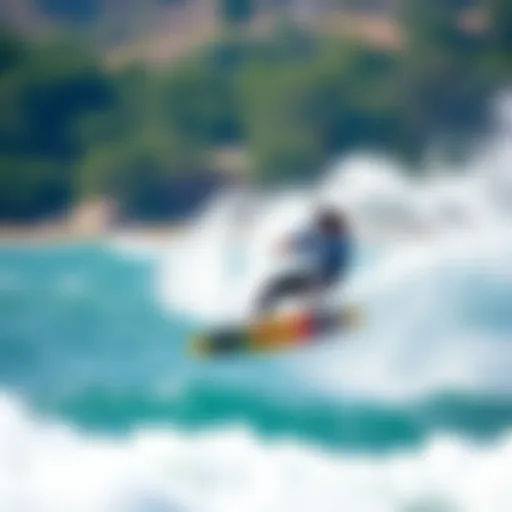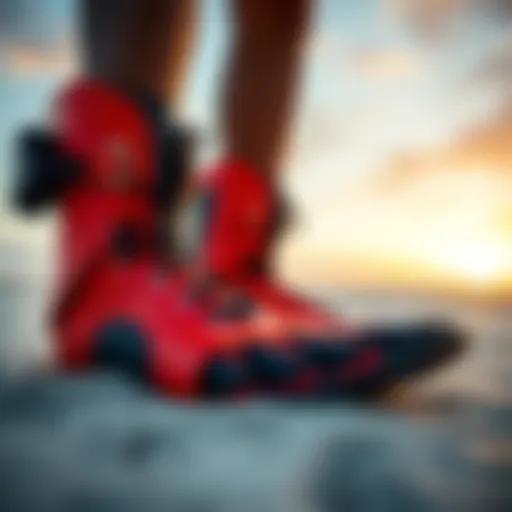Understanding Water Temperature Dynamics for Kiteboarding at Flagler Beach

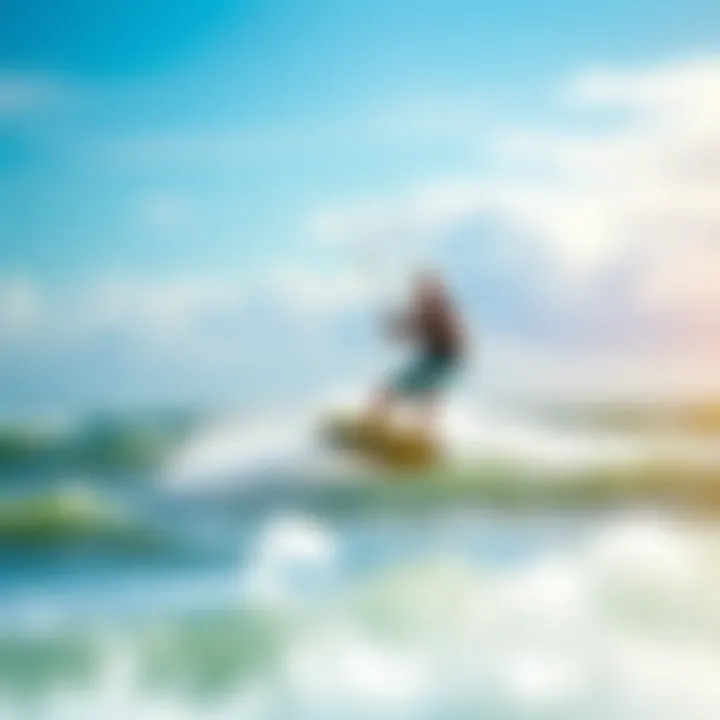
Intro
Kiteboarding at Flagler Beach is more than just a thrill; it's a dance with nature. At the heart of this excitement lies a fundamental element: water temperature. The nuances of temperature fluctuations dictate how kiteboarders perform and enjoy their time on the water. Unsurprisingly, understanding these dynamics can significantly enhance both safety and enjoyment.
As the seasons change, so does the water temperature, directly impacting not just the feel of the water, but also the behavior of the wind. For those who are keen on kiteboarding, being attuned to these shifts can mean the difference between a great day on the water and one fraught with challenges. Thus, we embark on a detailed exploration of water temperature's impact on kiteboarding—a journey that promises to deliver insights for everyone from beginners to seasoned veterans.
Through this lens, we will engage with essential topics surrounding gear, techniques, tips, and safety practices tailored specifically for the kiteboarding community at Flagler Beach.
Foreword to Flagler Beach
Flagler Beach may not be the biggest name on the map, but its unique allure attracts kiteboarders from all walks of life. Nestled along Florida's east coast, its beautiful stretch of shoreline offers not just stunning views but also a remarkable playground for water enthusiasts. Understanding this location is critical for kiteboarders hoping to make the most of their time here.
The interrelation of water temperature with kiteboarding practices presents invaluable insights. The beach's geographical features, seasonal shifts, and local weather patterns directly affect water temperature, which ultimately impacts both the performance and safety of kiteboarders. It's a complex web of dynamics that can dictate the difference between a day of exhilarating rides or a foiled outing.
Flagler Beach sits in a unique climatic zone characterized by warm temperatures most of the year. This makes it an ideal training ground for both newcomers and seasoned veterans. Factors such as wind patterns, local flora, and even aquatic life can contribute further nuances to the kiteboarding experience.
In summary, understanding the nuances of Flagler Beach prepares kiteboarders for the challenges and thrills that lie ahead. It’s not just about riding the waves; it’s about riding them smartly and safely, empowered by knowledge. A well-informed kiteboarder can dramatically enhance their experience, ensuring every ride meets or even exceeds expectations.
Reflecting on this, let’s delve deeper into the geographical makeup of this captivating beach that holds such potential for thrill-seekers.
Geographical Overview
Flagler Beach extends about six miles along the Atlantic Ocean, bordered by the picturesque lands of the Intracoastal Waterway. Its lapping waves and warm sun create an inviting atmosphere that draws in everyone from novice kiteboarders to seasoned professionals.
The beach itself boasts a mix of sandy shores and rocky outcrops, providing varied coastal conditions. This geographical diversity is instrumental in influencing wind patterns and, subsequently, water temperatures.
The oceanic currents that sweep through the area also play a role. They blend warmer tropical waters with cooler currents from the north, creating temperature gradients that can be felt while kiteboarding.
Historical Context
Over the years, Flagler Beach has evolved from a quiet fishing village into a vibrant hub for outdoor enthusiasts. The transformation initiated in the mid-20th century when more people discovered the recreational opportunities along its pristine coastline. Local events and surfing competitions began to showcase the area, paving the way for the current kiteboarding culture.
In fact, kiteboarding gained popularity particularly during the late 1990s. As the sport captured national attention, Flagler Beach’s conducive weather conditions made it an attractive destination for kiteboarding competitions and gatherings.
With this rich history in mind, kiteboarders not only have a natural playground but also a legacy they are part of.
Furthermore, it's essential to recognize how local authorities prioritize environmental conservation and water quality, which ensures that Flagler Beach remains a vibrant hub for water sports. A dedication to preserving the beach's natural beauty helps protect the resources vital for kiteboarding, making it a sustainable choice for enthusiasts.
Understanding Water Temperature
Understanding water temperature is crucial for kiteboarding at Flagler Beach. Water temperature directly influences not just how comfortable kiteboarders feel while on the water, but also plays a role in their performance. When temperatures vary, kiteboarders must adapt their gear and approach accordingly. For those looking to optimize their time on the water, recognizing these temperature dynamics is essential.
Definition and Measurement
Water temperature refers to the thermal state of the water that kiteboarders navigate. It’s measured using thermometers or digital gauges placed at various depths. An accurate reading helps riders determine the potential risks involved during their kiteboarding sessions. Knowing whether the water temperature is warm or chilly can dictate what equipment is most suitable. Typically, water temperatures are categorized into a range—cold, cool, warm, and hot. Each category has implications on comfort levels and performance during kiteboarding.
Factors Influencing Water Temperature
When examining how water temperature affects kiteboarding, several factors play key roles. These include atmospheric conditions, tidal patterns, and seasonal changes.
Atmospheric Conditions
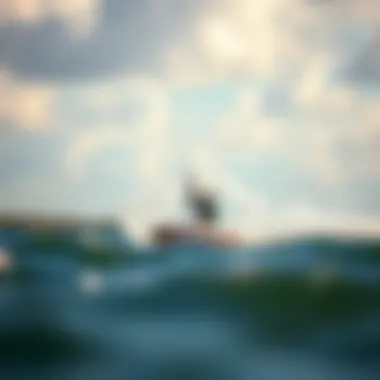
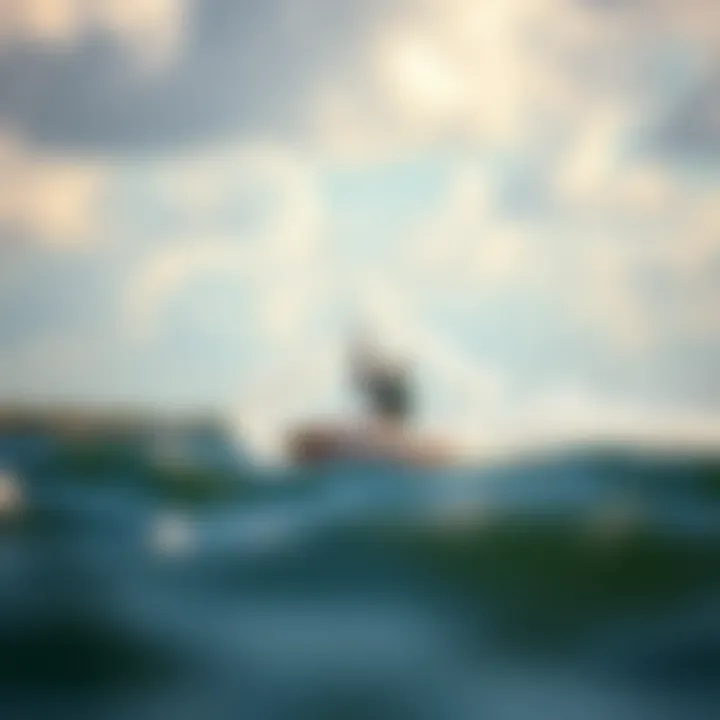
Atmospheric conditions encompass the weather and climatic elements surrounding Flagler Beach. Characteristics such as wind speed, sun exposure, and humidity significantly affect water temperatures. On breezy days when the sun is shining bright, water can heat up quickly, making conditions more enjoyable for kiteboarders. However, high winds can also lead to choppier waters, presenting its own challenges.
A unique feature of this dynamic is its variability; one day can feel vastly different from the next. Kiteboarders must stay savvy about these changes to capitalize on ideal conditions, making weather forecasting an essential part of planning a kiteboarding session.
Tidal Patterns
Tidal patterns also bear a significant influence on water temperature at Flagler Beach. As tides ebb and flow, they can lead to variations in temperature. In particular, incoming tides often bring warmer water from offshore, which can enhance the kiteboarding experience. It’s a favorable characteristic that kiteboarders should consider when heading out.
Understanding the timing of tides is vital. Kiteboarders can navigate safer and more enjoyable waters by syncing their session times with incoming high tides. But it’s worth noting that lower tides may expose more sandbars, impacting the riding conditions negatively.
Seasonal Changes
The seasonal changes introduce a rhythmic cycle that kiteboarders must consider closely. Winter temperatures tend to drop, while summer heats things up dramatically. Each season brings distinct characteristics that can dramatically affect kiteboarding sessions. During spring, for instance, water starts to warm up, attracting more enthusiasts to the shoreline. However, sudden shifts in temperature can occur due to cold fronts, impacting ride quality.
The unique feature of seasonal changes lies in their predictability, allowing kiteboarders to plan around them. Preparing for seasonal transitions means adjusting gear and managing expectations, especially knowing that early mornings in spring can still feel brisk despite the promise of warmer days ahead.
"Being aware of the seasonal ebb and flow of temperature can help kiteboarders navigate both challenges and advantages, ensuring the best possible experience on the water."
By considering the factors that influence water temperature, kiteboarders can enhance their skills and safety at Flagler Beach. Incorporating insights about atmospheric conditions, tidal patterns, and seasonal shifts lays the groundwork for more informed decisions and enjoyable sessions.
Seasonal Variations in Water Temperature
Understanding the seasonal variations in water temperature is crucial for kiteboarding enthusiasts at Flagler Beach. These fluctuations affect not only the physical characteristics of the water but also the overall experience and performance of kiteboarders. By grasping how temperature shifts throughout the year, novice and experienced kiteboarders alike can make informed choices about when to hit the water and how to prepare for different conditions.
Winter Conditions
Typical Temperatures
In winter, which runs roughly from December to February, the water temperature at Flagler Beach often hovers between 60°F to 65°F (15°C to 18°C). Though these temperatures may feel brisk, they also provide a unique atmosphere for kiteboarding. The benefit of riding at these cooler temperatures is that the crowds are significantly thinner. Enthusiasts can enjoy expansive stretches of water with less traffic, allowing for better focus and practice.
One characteristic of winter riding is the refreshing challenge it offers. Gybes and jumps may feel crisper in the brisk air, and kiteboarders can hone their skills away from a bustling summer crowd. A downside to be wary of is that underwater currents can be stronger during this season. In this regard, preparing adequately with proper gear is essential.
Kiteboarding Implications
The implications of winter water temperatures on kiteboarding are notable. While some may shy away from the chill, riders often find that the conditions are ideal for those seeking to push their limits. Kiteboarding in the winter means being prepared for wind patterns that may shift more unpredictably, but it can lead to exhilarating sessions.
A key characteristic of winter driving is the necessity to wear appropriate gear. Drysuits or thick wetsuits become essential in maintaining warmth and, therefore, comfort during your session. However, the bonus is that the vibrant sunsets over the water during winter create an undeniably stunning backdrop for kiteboarders.
Spring Transition
Temperature Increases
As spring rolls around, typically from March to May, water temperatures begin to climb, reaching approximately 70°F to 75°F (21°C to 24°C). This gradual increase signals a significant change that boosts the morale of kiteboarders. Warmer water means a more comfortable experience and opens the door for new gear options that are less bulky than in winter.
The charm of spring is that it often brings more stable winds, enhancing the kiteboarding experience. Spring temperatures are appealing because they allow kiteboarders to don lighter wetsuits or even shorties, enhancing movement in the water. However, be mindful that the warming waters can attract more marine life, so awareness is key.
Best Practices for Enthusiasts
With the shifting temperatures, kiteboarders should adopt new practices as the spring season approaches. It’s advisable to monitor weather patterns closely, as sudden changes can still occur. Knowledge of local fauna will also benefit safety, as spring often sees an uptick in jellyfish encounters.
Another important aspect is ensuring that your gear is in top shape for spring sessions. Take this time to inspect lines and check for any wear in the kite itself. An annual spring tune-up can prevent mishaps down the road.
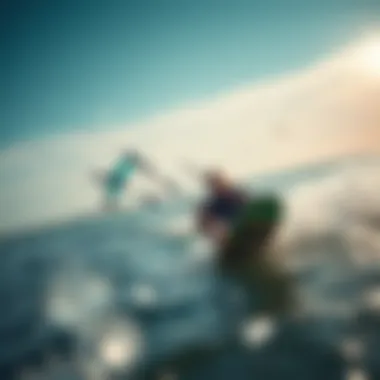
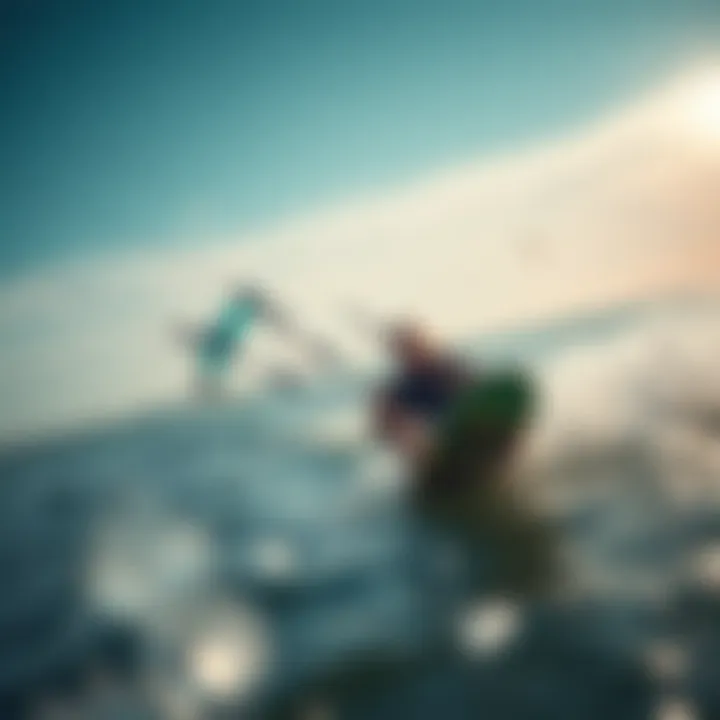
Summer Peaks
High Temperature Patterns
When summer hits, typically from June to August, water temperatures soar, often reaching highs of 80°F to 85°F (27°C to 29°C). This warmth turns Flagler Beach into a bustling hub of activity, with kiteboarders flocking to the beach for sunlit sessions. The water becomes smoother, with fewer choppy edges, making for exciting rides.
The appeal of kiteboarding in such warm waters is undeniable. Riders can wear lighter gear, and the comfortable conditions allow them to spend longer times on the water. However, with increased temperatures, also comes increased caution. The heat can lead to dehydration, and intense sun exposure can be a concern.
Safety Considerations
In summertime, kiteboarders need to practice proper hydration and sun protection. Sunscreen becomes non-negotiable, and waterproof varieties are recommended to withstand the splashes. Remember, the two-edged sword of summer bliss includes risks; thus, keeping an eye on the weather for storms becomes all the more important.
All in all, understanding the nuances of these high temperatures is key to enjoying the exhilarating kiteboarding environment Flagler Beach offers during the summer months.
Autumn Trends
Cooling Trends
As summer fades into autumn, spanning September to November, the water temperature begins to cool at a steady pace, dropping down to around 70°F to 75°F (21°C to 24°C) once more. This cooling effect can have a big impact on kiteboarders as they transition from summer gear back to slightly heavier options, preparing them for the upcoming winter months.
The beauty of autumn lies in its combination of comfortable temperatures and manageable crowds. Wind patterns can also remain favorable, offering kiteboarders a great opportunity to enjoy the sport before gear must be altered for colder waters.
Optimal Kiteboarding Conditions
Autumn’s unique blend of mild temperatures and wind stability makes it an optimal time for kiteboarding. Kiteboarders can take advantage of the transition by refining their skills without the summer hustle, thus allowing for focused, quality sessions. This season calls for a keen eye on the weather although the risks of unpredictability tend to decrease.
Being aware of changing winds and air temperatures helps amplify the kiteboarding experience, not to mention the stunning autumn scenery that frames the sessions, making for an exhilarating and serene atmosphere.
In short, understanding how water temperature fluctuates through the seasons at Flagler Beach is vital for kiteboarding enthusiasts. Knowing when to ride, what gear to bring, and what to anticipate allows for safer and more enjoyable sessions on the water.
Impact of Water Temperature on Kiteboarding Mood and Performance
In kiteboarding, the stakes are high, and the thrill is often tied to elements beyond just the wind and waves. Water temperature plays a critical role in shaping both the mood and performance of kiteboarders. It’s not just about what feels good; it’s about how water temp influences physical comfort, overall energy, and technical abilities while out there tearing up the surf. Getting a grip on these influences leads not just to a better day at the beach, but also to a more enriching kiteboarding experience.
Physical Comfort and Gear Choices
When it comes to kiteboarding, feeling comfortable in the water can mean the difference between a good session and a great one. Cold water can cut like a knife, leading to numbing sensations that can distract from the thrill of riding. In contrast, overly warm water can feel like a swimming pool on a sweltering summer day, zapping energy and motivation.
To combat the chill, kiteboarders often opt for thicker wetsuits during winter months. For example, a 5/4mm wetsuit is a common choice in the cooler months, providing a good balance of insulation and flexibility. Meanwhile, lightweight rash guards or shorties are more popular in the blazing summer sun, allowing for maximum freedom of movement.
"The right gear not only protects but enhances the joy of kiteboarding—having the proper suit can be the difference between buzzing with excitement or battling discomfort."
Kiteboarders should pay attention to the preferred gear based on the water's temperature. It’s often advised to test gear before heading out extensively. Finding that sweet spot in comfort allows riders to focus on skill rather than suffering.
Technical Performance Factors
Buoyancy and Control
Buoyancy is a word kiteboarders might often hear, but its implications can make or break a session. Water temperature affects the density of water, influencing how buoyant a board feels as it glides across the surface. Colder water can yield a denser medium, impacting how the board rides and how easily it sticks to the surface. Finding the right balance is crucial; too little buoyancy may lead to drag while too much can make control tricky.
Moreover, kiteboarders often prefer boards with specific designs and shapings that align with the season’s temperature. For instance, a board that does well in summer’s warm waters may not perform as effectively in the chill of winter, where a different design may help regain that much-needed control.

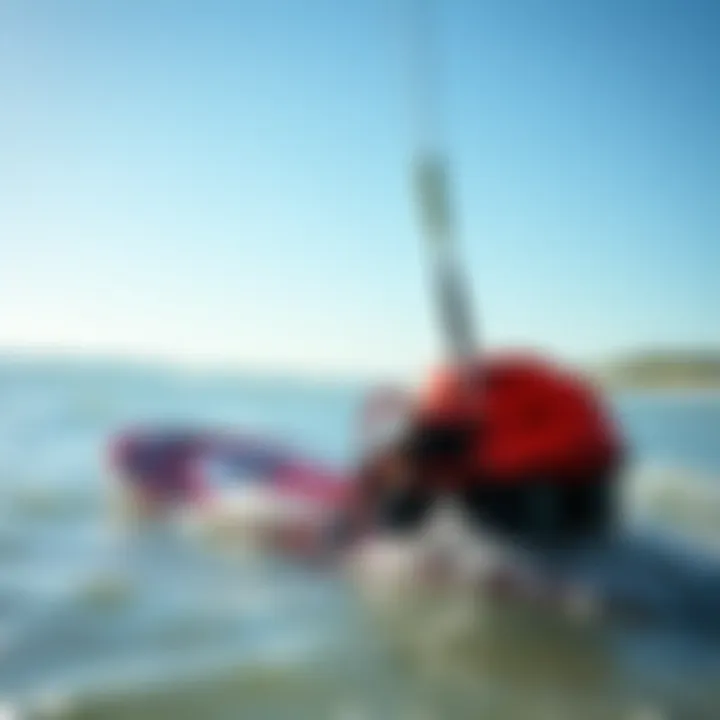
Unique to kiteboarding, buoyancy allows for a more dynamic interaction with the water, leading to sharper turns and more responsive slides. Choosing a board that aligns with expected conditions can greatly enhance a session.
Energy Expenditure
Energy expenditure relates closely to how kiteboarders harness the natural elements around them. At varying water temperatures, the amount of energy needed to move effectively can shift. When water temperatures drop, it requires more energy to maintain movement and stay agile. Conversely, warmer waters might lead to fatigue more quickly, not through cold, but through heat exhaustion.
The science here is straightforward: cooler water facilitates greater efficiency in riding because the body doesn't overheat, keeping energy levels higher for more extended periods. Thus, understanding how water temperature impacts energy efficiency will help kiteboarders adjust their strategies on the water, prolonging their ability to ride successfully.
Optimal performance relies on finding the right equilibrium where gear, water temperature, and individual energy levels come together seamlessly. This understanding not only allows for enhanced confidence between waves, but it also optimizes enjoyment out there.
In summary, the dynamism of water temperature isn’t something to be taken lightly. It molds both the mental and physical aspects of kiteboarding, marking its presence in every session, and ensuring that kiteboarders remain aware and well-prepared for any adventure that awaits.
Safety and Precautions Related to Temperature
The significance of safety precautions and understanding temperature in kiteboarding cannot be overstated. Kiteboarders, whether they are seasoned pros or enthusiastic newcomers, face various challenges tied to water conditions. Knowledge about the water temperature at Flagler Beach not only affects performance but also plays a critical role in ensuring safety.
When kiteboarding, it's crucial to be aware of the temperature impacts on your body and equipment. Cooler temperatures can lead to decreased bodily warmth, posing the risk of hypothermia. Conversely, higher temperatures may overheat you, diminishing your reaction time and overall performance. Recognizing these nuances helps kiteboarders make informed choices about their time on the water, empowering them to navigate both enjoyable and safe experiences.
Understanding Hypothermia
Hypothermia occurs when body temperature drops significantly below the normal range, usually defined as 98.6°F (37°C). Kiteboarders should particularly be on alert during the winter months when water temperatures can nosedive. Symptoms might start subtly, such as shivering, fatigue, or confusion but can escalate rapidly to loss of coordination and unconsciousness.
- Factors Contributing to Hypothermia:
- Prolonged exposure to cold water can sap energy and lead to hypothermia more quickly than one might assume.
- Wind chill can exacerbate heating loss, making it feel colder than it actually is.
- Wearing wet gear instead of dry suits can also contribute to faster heat loss.
To mitigate these risks, having a plan is vital. Bring extra gear, understand the water temperature forecast, and pay attention to how your body feels out on the water. Remember, when it comes to hypothermia, it’s always better to err on the side of caution.
Risks of High Water Temperatures
High water temperatures, often observed in summer months, bring their own set of hazards. While kiteboarding in pleasantly warm water may sound delightful, the underlying risks can catch many off guard.
- Dehydration and Heat Exhaustion: Just as you must be wary of the cold, heat-related illnesses can arise easily during hot weather, particularly if a rider forgets to drink sufficient water during an outing.
- Equipment Stress: Warmer waters can also affect the performance of kiteboarding gear. For example, softer hardwares like kite lines can stretch in higher temperatures, compromising their efficiency and potentially leading to equipment failure.
- Increased Wildlife Activity: Warm waters often draw more marine life, which can lead to unpredictable interactions. No one wants to run into a curious stingray or an overzealous jellyfish while zipping across the waves.
To face these risks head-on, kiteboarders should invest time into personal hydration strategies and be vigilant regarding their equipment’s condition. Pay attention to the weather forecasts, and don’t underestimate the potential hazards of warm conditions.
Educating oneself about temperature-related challenges not only fortifies personal safety but also enhances enjoyment, allowing kiteboarders to take to the Flagler Beach waters with confidence and assurance. In the world of kiteboarding, knowledge about temperature equates to power—power over how to navigate both the stunning and sometimes unpredictable nature of the water.
Culmination: Optimal Kiteboarding in Flagler Beach
Understanding the water temperature at Flagler Beach is key to enjoying a fruitful kiteboarding experience. This conclusion synthesizes the information discussed throughout the article, bringing together various factors that kiteboarders should consider for optimal performance and safety.
Summarizing the Temperature Impact
The relationship between water temperature and kiteboarding cannot be overstated. Variations in temperature influence not only the physical comfort of enthusiasts but also their performance. Cooler water can lead to faster fatigue and a greater risk of conditions such as hypothermia, which can turn a day of fun into a medical emergency. Conversely, too much warmth might increase fatigue without sufficient hydration. The perfect range for comfort generally falls between 68°F to 80°F, where most riders can remain active and agile.
By being aware of the seasonal changes, kiteboarders can tailor their gear choices effectively. For instance, donning a wetsuit in cooler months can maintain body heat while ensuring buoyancy. In warmer months, when temperatures soar, the choice of lighter gear becomes paramount to avoid overheating.
"Water temperature directly affects performance; be informed, be prepared!"
Future Considerations for Enthusiasts
As the world continues to change, so do the patterns of weather—climate change affects water temperature trends, not just locally but globally. Kiteboarders in Flagler Beach must remain vigilant about these shifts. Here are few considerations for enthusiasts:
- Adaptation of Gear: Keep up-to-date with advancements in gear that offer better thermal regulation and are responsive to changing water temperatures.
- Monitor Local Conditions: Platforms like Windy or NOAA provide real-time data that can help kiteboarders plan their sessions well.
- Community Awareness: Sharing experiences and insights within the kiteboarding community can foster a culture of safety and preparedness.
Ultimately, optimal kiteboarding is about synergy with the environment. Understanding the nuances of water temperature while considering safety measures can significantly enhance the kiteboarding experience at Flagler Beach, making it enjoyable today and sustainable for future generations.











